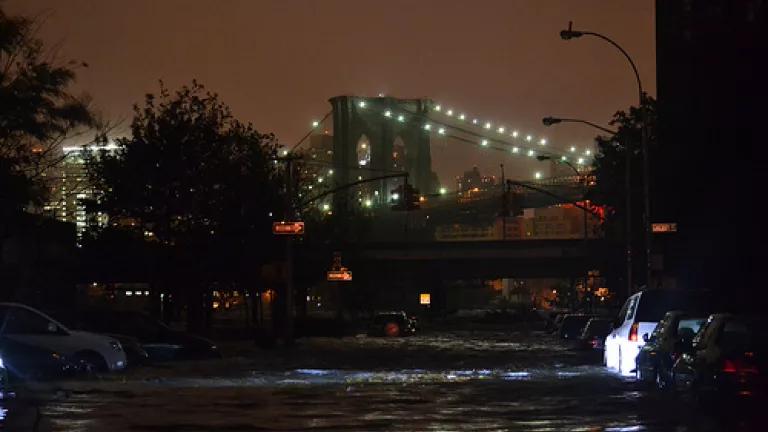Honoring the Anniversary of Sandy by Making Our Communities More Resilient: 10 Ways to Begin

The Beach Haven Elementary School sat shuttered for most of last year. Superstorm Sandy flooded the New Jersey school and severely damaged its floors and ceilings. Students were assigned to classrooms 15 miles away to finish out the year. But this September, the fully repaired building opened its doors once again and welcomed students back to school.
Similar stories of recovery have emerged across New Jersey and New York. Some residents continue to struggle, but many have rebounded from the turmoil of the storm. As a child of New Jersey and a resident of New York, I know this is a resilient place, and we have proven it once again.
Yet even as we mark the progress of the past year, we must prepare for the storms of the future. To help us get there, today NRDC has released a list of the 10 steps we can take to ensure our region thrives in an altered climate.
Climate change is bringing more intense storms, higher storm surges, and more frequent flooding to our region. Hurricane Sandy surprised many with its ferocity, but the biggest mistake we could make is to fail to learn from the lessons of the past year and be surprised yet again. We can start by making our communities more resilient and reducing the pollution that causes global warming.
Our leaders recognize the need to prepare for a changed climate. Governor Andrew Cuomo has said, “I think part of learning from [Hurricane Sandy] is the recognition that climate change is a reality. Extreme weather is a reality. It is a reality that we are vulnerable.” Mayor Michael Bloomberg has said Hurricane Sandy and other extreme events reveal the need for local and national leadership on climate change. And Governor Christie has acknowledged that "climate change is real" and that "human activity plays a role in these changes."
We credit their leadership and the efforts of all officials in the region—from first selectmen to legislators, zoning commissioners to public housing experts—who are helping our region respond to a changing climate. We urge elected officials to stay on this path and follow through with resiliency efforts now, before the memories of Sandy fade.
To help us move forward, NRDC has laid out 10 key ways we can prepare our communities for future storms. These recommendations follow a set of fundamental principles:
Rebuild Smarter
Hurricane Sandy destroyed thousands of homes and business and dashed countless dreams along with them. Behind every red-tagged house or gutted shop is a family who has lost their anchor. To prevent this kind of heartache in the future, we must carefully consider how and where we rebuild. If we are not careful, many families could find themselves in the same painful position when the next super-storm hits in five or ten years. We can help prevent this by expanding floodplain buy-out programs to compensate people who relocate to safer ground. We can reform the National Flood Insurance Program so people are no longer encouraged to live in floodplains. And we can require planning organizations to develop performance measures for climate preparedness
Ensure Future Development Respects Mother Nature
Scientists have made it clear that powerful weather events will become more frequent. Storms we used to expect once every 100 years could now come every 10. The new FEMA flood maps recognize this changing reality. Twice the number of structures in New York City are now in flood zones than the previous maps indicated. These are daunting developments, but Mother Nature can act as a guide. Natural systems like wetlands, dunes, and oyster reefs have proven effective at reducing flood risk. We can help shield our communities by enhancing these natural barriers and increasing investment in things like pocket parks, rain gardens, and other green infrastructure solutions that absorb stormwater runoff.
Strengthen Critical Infrastructure and Public Health Response
More than 8 million businesses and households went without power, subways and trains were out of service, and water treatment plants were taken offline. We can minimize these impacts with careful planning. We can make sure our water, energy, and transportation systems are able to function before, during, and in the aftermath of a disaster. We can create preparedness programs specifically for susceptible populations. And we can urge FEMA to require states to develop disaster preparedness plans that recognize and assess the risks that come with our changing climate.
Address the Root Causes of Climate Change
Even as we make our communities stronger, we must also tackle this challenge at its source carbon pollution. New York and Connecticut belong to the Regional Greenhouse Gas Initiative to cut carbon from power plants and New York City has been a leader in energy efficiency. But we can do more to tap our area’s abundant clean energy resources. At the same time, we can also work as a nation to reduce carbon pollution. President Obama laid out a national climate plan in June that included setting limits on carbon pollution from power plants. We urge residents hit hard by Hurricane Sandy to add their voices to the growing chorus for bold climate action.
As we reflect back on the lives lost and the damage done nearly a year ago, we must honor the people who suffered by doing everything we can to better prepare for the future.
Photo credit: Jason A. Howie
